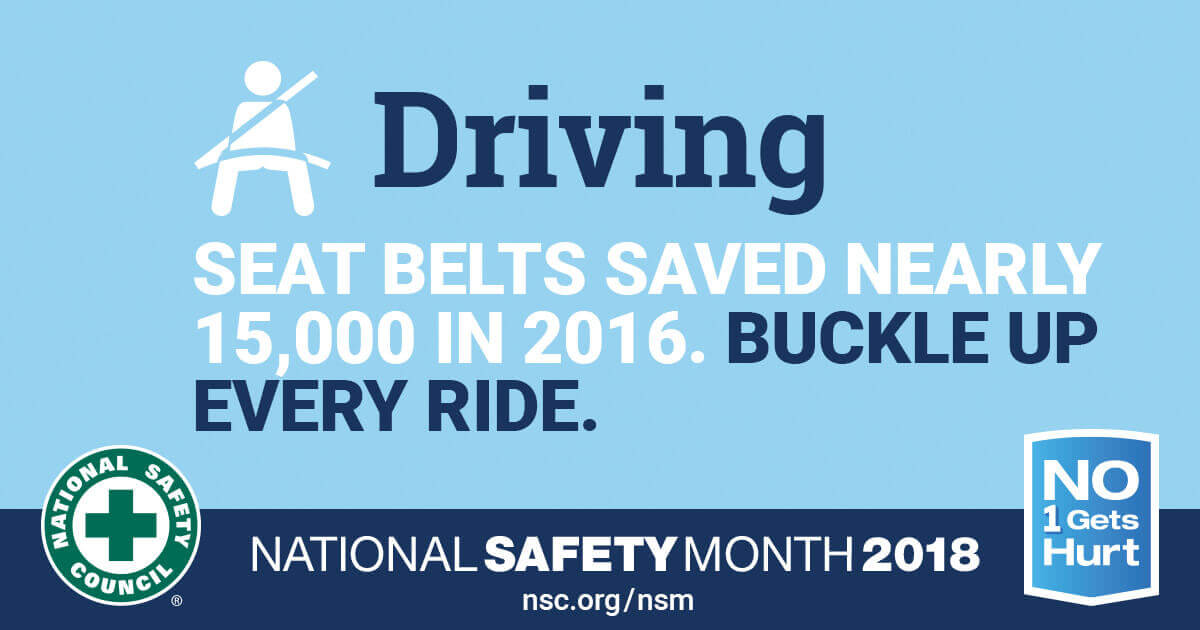Make One Change for Safety this National Safety Month
Posted on by June is National Safety Month,
an opportunity to help prevent unnecessary injuries and deaths at work,
on the roads, and in our homes and communities. With this year’s theme,
No 1 Gets Hurt, we are encouraging readers to think of at least one
change you can make to improve safety this month. This joint blog from
NIOSH and the National Safety Council (NSC) highlights the weekly themes
of emergency preparedness, wellness, falls and driving. Help us spread
the word about National Safety Month to your family, friends and
co-workers. Use the information below, download and share free materials from the NSC website, and visit the NIOSH website to help ensure that No 1 Gets Hurt.
June is National Safety Month,
an opportunity to help prevent unnecessary injuries and deaths at work,
on the roads, and in our homes and communities. With this year’s theme,
No 1 Gets Hurt, we are encouraging readers to think of at least one
change you can make to improve safety this month. This joint blog from
NIOSH and the National Safety Council (NSC) highlights the weekly themes
of emergency preparedness, wellness, falls and driving. Help us spread
the word about National Safety Month to your family, friends and
co-workers. Use the information below, download and share free materials from the NSC website, and visit the NIOSH website to help ensure that No 1 Gets Hurt.Week 1: Emergency Preparedness
NIOSH: The NIOSH Emergency Preparedness and Response (EPR) program integrates occupational safety and health into emergency responses during planning and preparedness activities to protect response and recovery workers. Workers are the common denominator in an emergency event. Visit the EPR Program website for resources to protect the safety and health of first responders.NIOSH’s Emergency Responder Health Monitoring and Surveillance™ (ERHMS™) framework provides recommendations for protecting emergency responders during small and large emergencies in any setting. You can download the free ERHMS Info Manager™ software from the NIOSH website.
NIOSH has been active in addressing the opioid epidemic and the workplace. Fentanyl is a powerful synthetic drug that is similar to morphine and heroin, but is 50 to 100 times more potent. Fentanyl and related drugs can pose a potential hazard to law enforcement, emergency medical personnel, and firefighters who could come into contact with these drugs through the course of their work day. See the blog Fentanyl Exposure Risks for Law Enforcement and Emergency Response Workers for information about exposure routes, prevention, and recent research.
NSC: Emergency situations can happen at any time, making it crucial that you are prepared for the unexpected including natural disasters, fires, active shooter situations or chemical or gas releases. It is best to be prepared both at work and home. Actively participate in workplace drills. With violent acts on the rise, know how to respond to an active shooter with free NSC training at nsc.org/communitytraining. At home, create emergency plans with your family. It is also helpful to put together emergency kits for both your home and car.
In the event of an emergency, one of your best defenses against harm is to be trained in First Aid. Our First Aid infographic and App can help you be prepared. Since the first week of June is also CPR and AED Awareness Week, the Council is offering our NSC First Aid Online course for free between June 1 and June 10. Availability is limited.
Week 2: Wellness
NIOSH: The Total Worker Health® (TWH) program at NIOSH advocates for a holistic approach to worker safety, health and well-being that explores opportunities to both protect workers from hazards and advance their health and well-being. The TWH approach integrates health protection with broader interventions to advance worker well-being by targeting job conditions and encouraging health and safety improvements starting at the organizational level.Getting enough sleep is important to do your job safely. And, there are some jobs where sleep plays an even more important role in ensuring the safety and health of workers and the people they serve. For example, NIOSH has guidance on organizational and individual strategies on how to reduce risks from workplace fatigue for truck drivers, pilots, emergency responders, and healthcare workers. Nurses can earn free CEs for taking the course!
High stress levels, especially for prolonged periods of time, can lead to hypertension, cardiovascular disease, obesity, and diabetes. Work-related stress can lead to risk of injury and depression, which contributes to absenteeism, presenteeism (workers going to work when they are sick), disability, and unemployment [Schnall, Dobson, Landsbergis, 2016[i]]. Further evidence demonstrates that employees who report stressors such as low job control or high job strain have an increased incidence of ischemic heart disease [Theorell et al., 2016[ii]].
Providing training for supervisors on approaches to reducing stressful working conditions can improve employee health, reduce turnover, and increase employee retention. Learn about Total Worker Health strategies to reduce worker stress by viewing this NIOSH Total Worker Health webinar: Intervening for Work Stress: Work-life Stress and Total Worker Health Approaches. For more information about designing programs to support worker safety, health and well-being, please see Fundamentals of Total Worker Health® Approaches: Essential Elements for Advancing Worker Safety, Health, and Well-Being and https://www.cdc.gov/niosh/programs/hwd/default.html
NSC: As NIOSH mentioned earlier, opioid-related deaths have reached epidemic levels. Part of the problem is, many people don’t know they are taking an opioid, which include commonly prescribed drugs such as Vicodin and Percocet. It is important for doctors and patients to have a conversation about the medications being prescribed, the potential risks and whether an alternative non-opioid treatment may be more appropriate. Be proactive and order free Warn Me labels for insurance and prescription cards to help prompt that critical discussion. Order labels for yourself or sheets of labels for your workplace. Visit stopeverydaykillers.org for more information.
You can also find out what opioids are costing your organization by using our NSC Substance Use Cost Calculator. Addressing this issue is not only the right thing to do, but can help your organization’s bottom line.
Another growing concern that organizations need to pay attention to is worker fatigue. Employer practices and policies have a significant influence on the potentially deadly impact of employee fatigue. Getting 7-9 hours of sleep every day is key. The Council has many resources on fatigue including infographics, videos, research and reports, including another that will be released in mid-June as the second of a three-part series. Fatigue also has many economic costs for organizations. Check out the NSC Fatigue Cost Calculator to assess how fatigue financially impacts your workplace.
Week 3: Falls
NIOSH: Falls remain a persistent but preventable problem in the workplace. Falls are the number one cause of construction-worker fatalities, accounting for one-third of on-the-job deaths in the industry. This year marked the fifth National Stand-Down to Prevent Falls in Construction part of the larger National Campaign to Prevent Falls in Construction. Join the campaign today and download the fall prevention infographics.The highest number of nonfatal fall injuries continue to be associated with the health services and the wholesale and retail industries. Data show that in 2016, work-related ladder fall injuries in the United States resulted in 172 fatalities[iii], an estimated 16,990 nonfatal injuries[iv] that involved days away from work, and an estimated 46,000 nonfatal injuries treated in emergency departments[v]. Download NIOSH’s award-winning Ladder Safety app today to learn how to prevent extension and step ladder falls. You can also watch the joint ISSA and Total Worker Health webinar on “Preventing Slips, Trips, & Falls at Work and Beyond”.
NSC: Falls are the third leading cause of unintentional-injury-related deaths for all ages and the No. 1 cause of death for those 65 and older, according to Injury Facts. Falls from heights often cause more serious injuries and deaths. The Council’s new Safety from Heights resources offer best practices, planning tools and more to keep workers safe.
Falls are a safety risk for many age groups. Use the Council’s Safety Checkup Tool to identify your personal risks. In fact, preventable injuries are now the third leading cause of the in the U.S. Register now for our free webinar on June 21 to find out Why Preventable Deaths Are on the Rise.
Week 4: Driving
NIOSH: Motor vehicle crashes are the leading cause of work-related deaths in the U.S. All workers are at risk of crashes, whether you drive light or heavy vehicles, or whether driving is a main or incidental job duty. Behind the wheel, driving is your number 1 job. There are simple actions you can take to stay safe while driving:- Buckle up: every trip, every person. It only takes a second.
- Do not drive if you are fatigued. Stop and take breaks as needed.
- Focus on driving and stay aware of your surroundings. Other drivers may be impaired, fatigued or distracted.
- Talk to your supervisor and co-workers about potential hazards on your planned route, including road construction, bad weather, or dangerous curves.
NSC: We all believe ourselves to be safe drivers, yet up to 94 percent of motor vehicle crashes involve human error. One simple step we can all take is to buckle up every trip, every time.
Impairment plays a role in many crashes and can take several forms – distraction, drugs, alcohol as well as fatigue. NSC offers a free Safe Driving Kit to help employers address all of these issues. NSC is also offering a free 20-minute Avoiding Fatigued Driving online session between June 24 and June 30 – availability is limited.
Although new technologies have added to the distraction on the roads, there are other technologies making us all safer. Visit MyCarDoesWhat.org to stay up to date on the safety features in your car. You can also visit CheckToProtect.org to regularly check your vehicle for recalls.
 The Council believes we can eliminate preventable deaths on our roadways. If you do too, consider joining the Road to Zero Coalition, comprised of more than 700 organizations committed to ending all roadway fatalities by 2050.
The Council believes we can eliminate preventable deaths on our roadways. If you do too, consider joining the Road to Zero Coalition, comprised of more than 700 organizations committed to ending all roadway fatalities by 2050.Please share with us what actions you will take this month to ensure that No 1 Gets Hurt.
Dawn Castillo, MPH, is the Director of the NIOSH Division of Safety Research.
Kim Shambrook is Senior Director of Safety Education & Training at the National Safety Council.
References
[i] Schnall P, Dobson M, Landsbergis P [2016]. Globalization, work, and cardiovascular disease. Intl J Health Serv 46(4):1–37.[ii] Theorell T, Jood K, Jarvholm S, Vingard E, Perk J, Ostergren PO, Hall C [2016] A systematic review of studies in the contributions of the work environment to ischaemic heart disease development. The European Journal of Public Health 26(3): 470-477.
[iii] U.S. Department of Labor, Bureau of labor Statistics, in cooperation with State, New York City, District of Columbia, and Federal agencies, Census of Fatal Occupational Injuries. Fatal occupational injuries by selected worker characteristics and selected primary source (Ladders, code 74XXXX), All U.S., all ownerships, 2016. May 14, 2018. Available from: https://data.bls.gov/gqt/RequestData.
[iv] U.S. Department of Labor, Bureau of labor Statistics, Survey of Occupational Injuries and Illnesses. Number of nonfatal occupational injuries and illnesses involving days away from work by selected worker and case characteristics and source of injury/illness (Ladders, code 74XXXX), All U.S., private industry, 2016. May 14, 2018. Available from: https://data.bls.gov/gqt/RequestData.
[v] NEISS-Work data (ED-treated) for 2016. May 16, 2018.
=================================
National Safety Month Free Materials
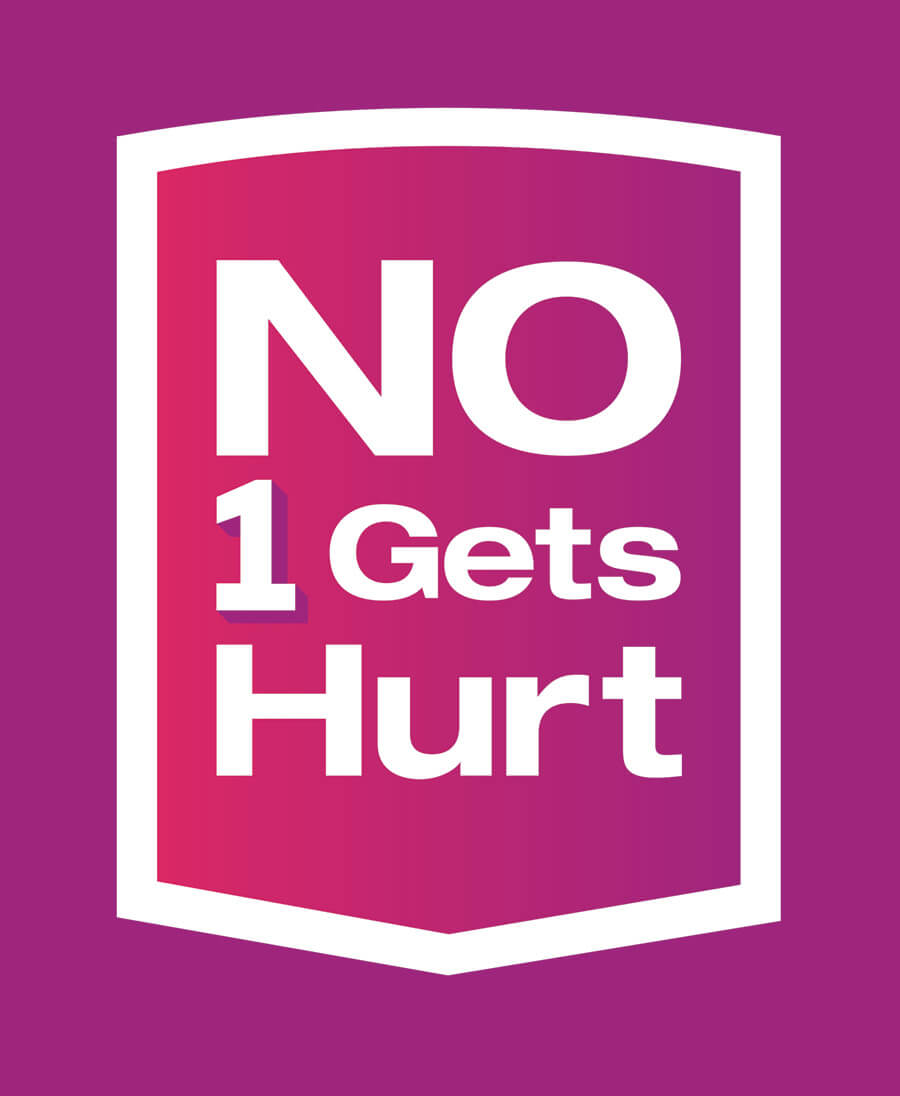 Thank you for your interest in National Safety Month. Download and share these materials to help identify risks and ensure
No 1 Gets Hurt.
Thank you for your interest in National Safety Month. Download and share these materials to help identify risks and ensure
No 1 Gets Hurt.
Think of at least one change you can make to improve safety this June. Use these resources during the designated weeks, or create a schedule that works best for your organization.
Week 1: Emergency Preparedness
- Additional Resources
- Social Graphic:
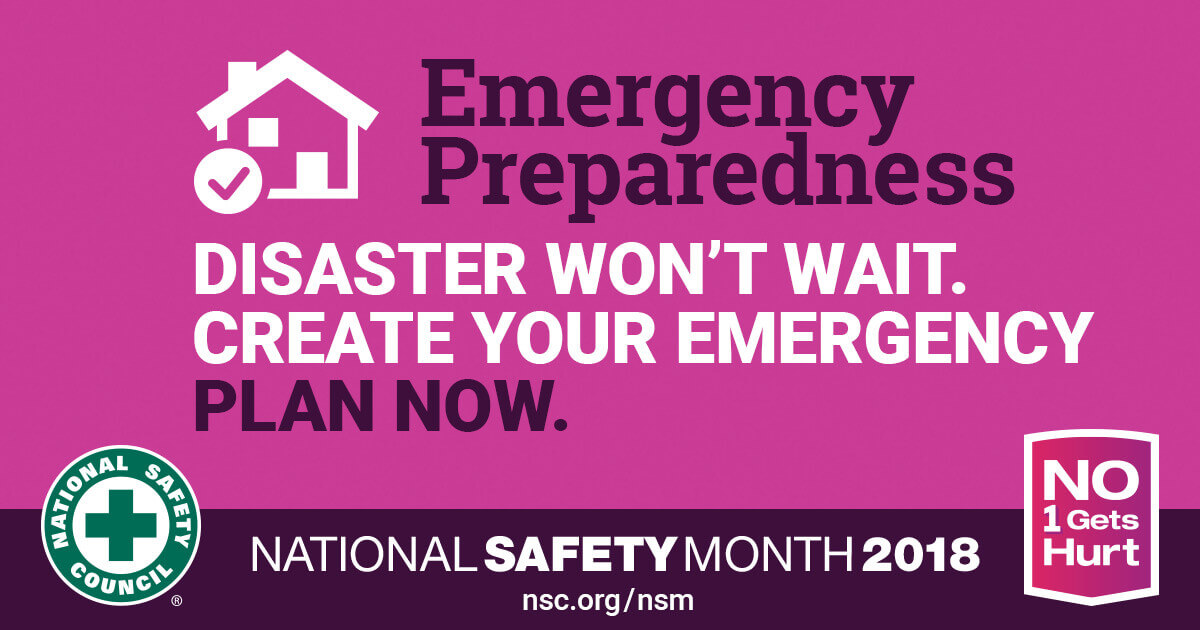
Week 2: Wellness
- Tip Sheet: English & Spanish
- Sample Wellness Program: NSC Wellness Plus Program
- Related articles:
- Additional Resources
- Social Graphic:
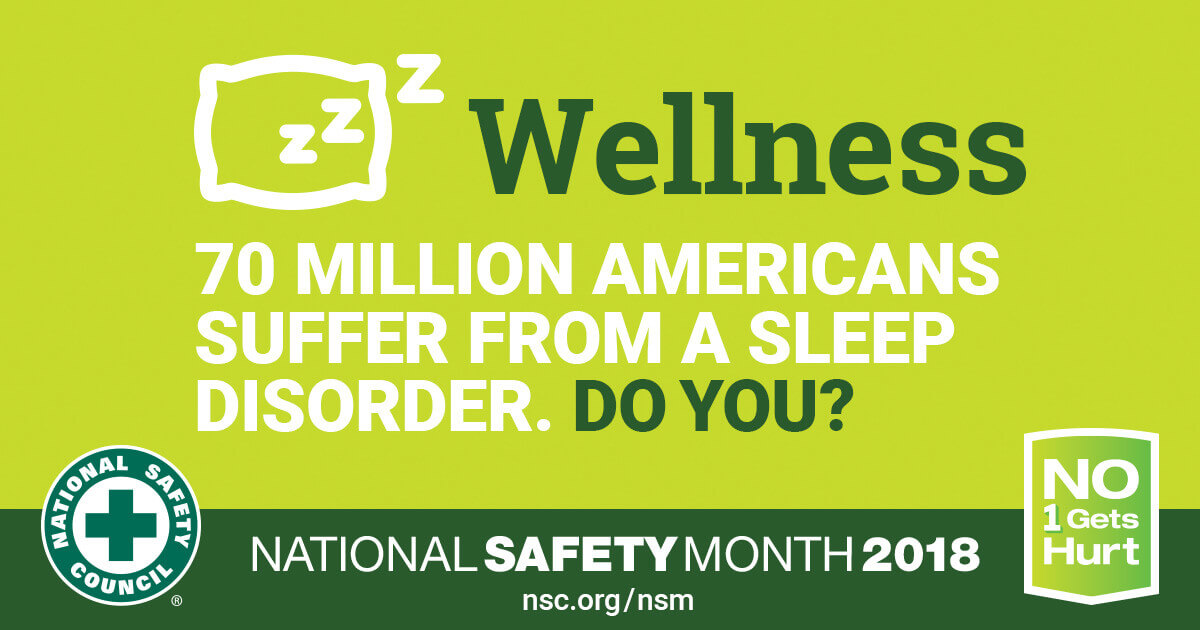
Week 3: Falls
- Additional Resources
- Social Graphic:
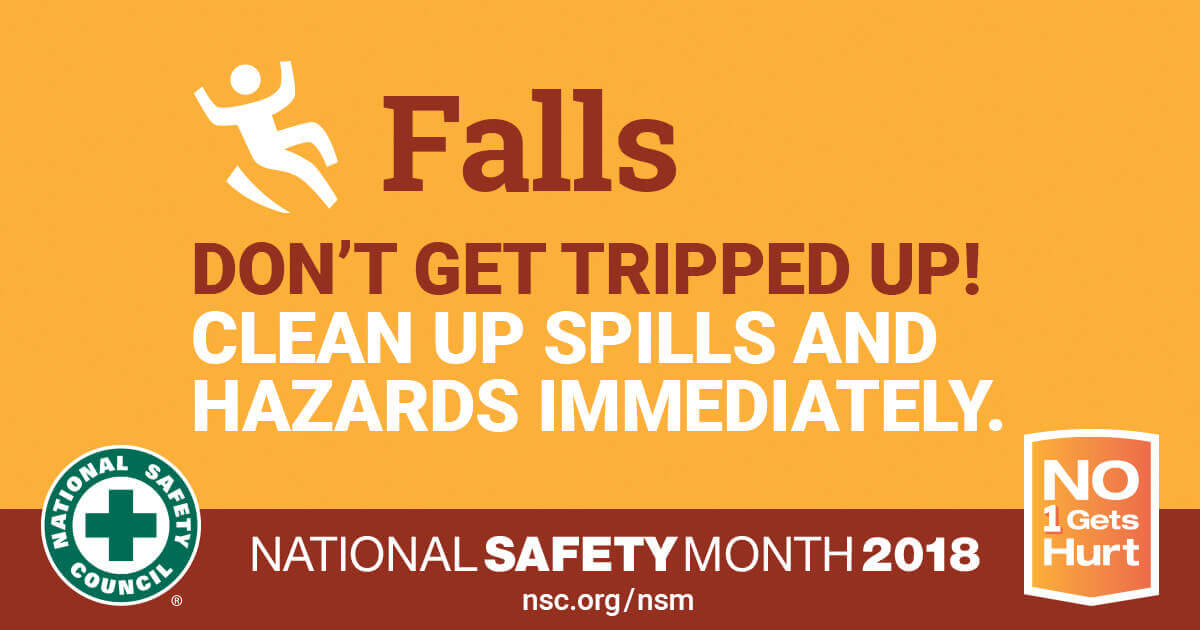
Week 4: Driving
- Additional Resources
- Social Graphic:
